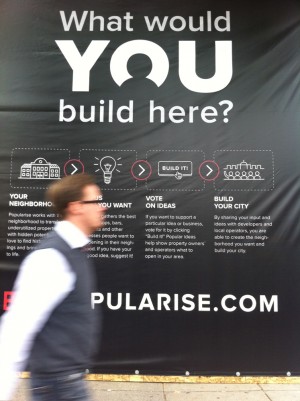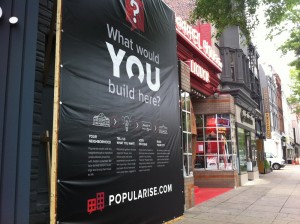Crowdsourcing Neighborhood Changes

Elahe Izadi / DCentric
A sign on 14th Street and Rhode Island Avenue NW asks "What would you build here?"
Businesses play an important role in the transformation of neighborhoods. A certain restaurant or store can attract newcomers, make a block seem “desirable” or become a gathering spot.
But as it stands now, the public generally doesn’t have a say on what specific businesses open up in their neighborhoods, says developer Ben Miller. Should that vacant storefront be a coffee shop or a pet store?
That’s why Ben Miller and his brother, Dan, started Popularise.com in late 2011. They were trying to figure out what to do with the building they purchased at 1351 H Street NE, and wanted public input. So they posted the project online and asked people to vote on ideas they had already explored or submit suggestions. About 1,000 people responded, and Ben Miller says they’ll announce the final project within a few weeks.
The site is in its early stages and currently features five buildings. People sign up by providing their names and zip codes and can then comment on project ideas or suggest new ones for the featured buildings. Building owners, developers and others then use the feedback as a factor in the eventual outcome, along with economics, construction issues and other things.
“A lot of people aren’t in the process of how neighborhoods get built. They don’t know how decisions get made,” Miller says. “A lot of it can be changed by including lots of people who normally don’t get involved.”
But is targeting an online audience the best way to increase involvement? A persistent digital divide in the District means there’s a good chunk of the population who is not connected, and they’re mostly low-income folks.

Elahe Izadi / DCentric
A large sign for Popularise.com asks passersby to weigh in on what should open at 14th Street and Rhode Island Avenue NW.
Miller says that his website isn’t shutting people out from the conversation, but rather widens it. Real estate development is an “opaque” process, he says. (Ben Miller, 35, grew up in D.C. and his father is well-known developer Herb Miller, whose company had a hand in Gallery Place, Potomac Mills and Washington Harbour).
Often times, few people show up to community meetings and a “very vocal group dominate the discussion. I don’t think they represent the majority,” Miller says. “Most people are busy and don’t have time to wait for hours in church basements. I think this is a much broader and more inclusive process than what [exists] today.”
Still, it’s clear that the website thus far has appealed to a particular demographic. According to the site’s data, the typical user is between 25 and 34 years old, lives near H Street (which makes sense, given their first project’s location) and likes frequenting Little Miss Whiskey‘s and Rock and Roll Hotel. But Miller says the site is essentially a self-organizing tool, and anyone can become part of the process. Community groups in other parts of Northeast have already approached him for help on revitalizing commercial corridors. United House of Prayer, which has helped build affordable housing in the city, is using the site to help develop some of its vacant properties, Miller says.
Miller doesn’t view his website as gentrifying neighborhoods since most of the projects involve vacant or blighted buildings. He calls them “win-win” properties, places people want developed.
For instance, there are few sit-down restaurants east of the Anacostia River, something residents have complained about. Miller says opening nice restaurants there would be an example of growth in an underserved area, not gentrification.
“My experience is everyone wants good schools, good services and a beautiful neighborhood,” Miller says.
-
http://twitter.com/squarelyrooted Squarely Rooted






